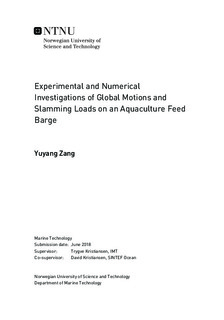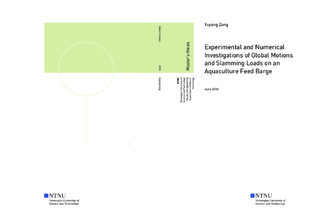| dc.description.abstract | Local slamming on an aquaculture barge will occur on a deck that is located lower than the main deck. The problem is dependent on the global motions of the structure. If the structure has decks that are located at the port- and starboard side, then the global roll motions will be essential for the problem. By obtaining correct global motions, the relative velocities of the structure and the waves can be calculated, which is further used in the slamming analysis. This consists of estimating correct global motions of a floating barge structure, conducting laboratory work, and making a similar numerical model in the potential solver, WADAM.
An estimation of roll damping ratio to a barge with sharp edges is conducted. The results are compared with experiments where linear waves with different wave periods and wave steepness are tested. The experiments are conducted in a small towing tank, "Lilletanken", at the Center of Marine Technology at NTNU. A rectangular shaped model with a scale of 1:25 is built, and a plate made by aluminum is used to act as the small platform. Between the attachment point of the platform, a force sensor is used to measure the slamming force from the global motions and from the waves. A decay test is performed in all six global motions, and the natural period in heave and roll are approximately 7.6s and 12.05s respectively in full scale. This corresponds well with the results from the potential solver.
Two laboratory experiments are conducted. One in January and one in April. The tests from January consist of different regular waves with many various steepness, but few wave periods. It is observed that global motions are largest at the steepest waves, and the slamming forces at the platform are largest when the structure is moving in heave. Furthermore, from the analysis of the results, it is decided to run more tests with more wave periods. Therefore, another experiment in April is conducted. The results from April show that the model is exposed to parametric instability when an incoming regular wave with full scale wave periods 6.0s up to 6.4s are tested. This instability is observed to be greater for large wave steepness.
Comparison of the results from the experiments and the numerical simulations show that the method for estimating the damping ratio is conservative. The results from the experiments are more damped at the resonance region than the simulated results. With an exception at the resonance region, the global roll motions obtained from the experiments correspond well with the numerical results. The wall effects are simulated by using mirroring techniques, and show consistent results with the experimental results.
Time series of the slamming forces are demonstrated. It is observed that the time duration of the high impact force is short, while there exist forces with negative values that have longer time duration after the impact. A sensitivity test of the frequency range for the filtering process of the measured slamming forces is conducted. The results show that the filter type should be a low-pass filter with a cut-off frequency at 200Hz. The measured slamming forces are compared with the analytic results calculated from Wagner model. Due to large uncertainties of the deadrise angle, the analytic results did not correspond well to the experimental results. However, the estimated slamming forces show an upper and lower limit of the measured time series.
From the results of slamming force obtained from the experiments, it is shown that the slamming forces are dependent on various parameters. The main parameters that change the slamming forces are wave steepness, relative velocity, water density, added mass and global motions.
A perforated plate with same dimensions as the solid plate is tested. The results of the slamming forces are compared to each other, and it shows that the peaks of the impact force are much lower for the perforated plate. | |

